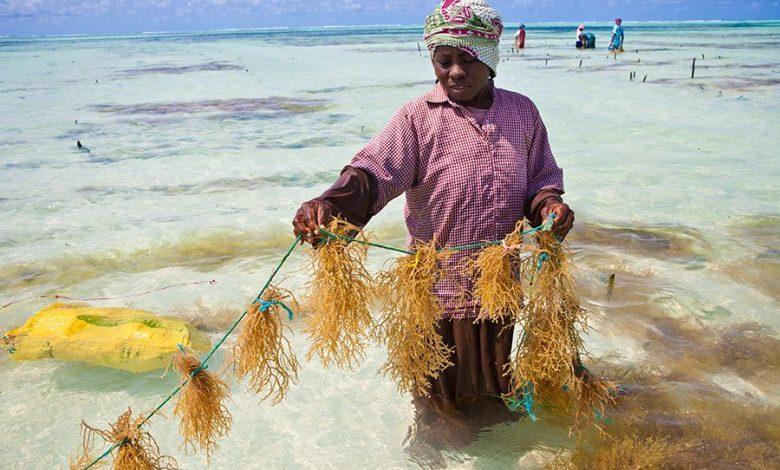Africa-Press – Tanzania. ALONG the sun-drenched shores of Tanzania’s coast, beneath the shimmering waves of Zanzibar, Lindi, Tanga, and Coast Region, something remarkable is happening.
The sea, once simply a source of fish or other sources of seafood, is being reimagined.
It’s becoming a living field, a floating farm, and for many, a lifeline.
Seaweed, quiet and unassuming, is transforming lives in ways that few would have imagined a decade ago.
Where fishing nets once cast for sardines, ropes now stretch across the shallow ocean floor, anchored by wooden stakes and gently cradling strands of seaweed. Before the morning tide rises, women, many of them mothers, grandmothers, and daughters, wade into the cool, waist-deep water, crouching over the lines with practiced hands.
They tie seedlings, one by one, with quiet determination, not just planting seaweed but weaving dreams into the sea. This isn’t just farming. It’s an act of faith.
Abdullah Mahzumi of the Zanzibar Seaweed Company (ZASCO) calls it more than a livelihood, it’s a way of life. And it shows. These coastal communities don’t just harvest seaweed; they live by its rhythms. School fees, daily meals, and medical bills are now paid from the harvests pulled from the ocean. The sea, long taken for granted, now holds a sacred promise.
But this promise doesn’t come without its trials. Farming underwater is no easy feat. It demands skill, patience, and a kind of intimacy with nature that can’t be taught overnight.
Cultivated seaweed varieties like Cottonii and Spinosum require a careful touch and a deep understanding of timing and technique.
That’s why local NGOs, cooperatives, and even international partners have stepped in, hosting training sessions before planting seasons. Farmers learn how to pick strong seedlings, when to plant and harvest, and how to dry the seaweed properly to preserve its market value. And still, the sea has moods of its own.
Climate change has started to whisper a harsh new truth into these coastal winds. The rains, once predictable, now arrive unannounced, sometimes drenching seaweed just as it’s ready to dry.
Salt gives way to fresh water, inviting rot and fungus. One ruined harvest can mean empty plates, unpaid school fees, and fading hope.
Then there are the more human challenges, accidental, but no less damaging. A bottle of mosquito spray stored too close to a drying mat, or seaweed packed under damp blankets, can spoil an entire batch. What should have been a marketable product becomes a loss, often due to a simple oversight or lack of proper storage. Yet amid all this, the tide is turning both literally and figuratively.
Small-scale entrepreneurs are no longer content to sell seaweed raw. They are infusing it into handmade soaps, turning it into skincare oils, blending it into flours, and exploring its culinary uses. From kitchen tables to small home workshops, seaweed is evolving into something more than a crop it’s becoming a craft. For women and youth along the coast, this value addition isn’t just creative, it’s revolutionary. It’s the difference between subsistence and sustainability.
And the government is listening. Once silent on seaweed pricing, it has stepped in with reforms, setting fairer prices and curbing the exploitation by middlemen who once bought low and sold high. With new policies in place, dignity has returned to the farmers. Pride glows on the faces of women who once had to accept whatever price was offered.
In Pemba, a newly built processing factory stands as a symbol of ambition. It signals a shift from raw export to refined value a chance for Tanzania to trade not just in volume, but in craftsmanship and quality. It’s a step toward a seaweed economy that benefits those who nurture it from the seabed up.
Out on the tidal flats, bent in the morning sun, these farmers do more than cultivate a marine plant. They grow resilience. With each tide that carries their seaweed lines, they pull in more than just a harvest; they pull in a future. Because for them, seaweed is not just an aquatic crop. Its a quiet revolution, rippling through the coastal waters of Tanzania, one strand at a time.
For More News And Analysis About Tanzania Follow Africa-Press







